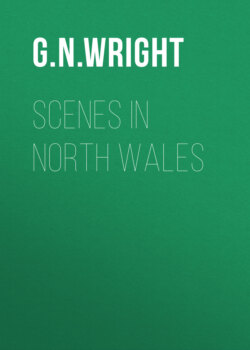Читать книгу Scenes in North Wales - G. N. Wright - Страница 10
На сайте Литреса книга снята с продажи.
SNOWDON, FROM CAPEL CURIG.
ОглавлениеTable of Contents
The Cairn, or Carnedd, on the summit of Snowdon is elevated three thousand seven hundred and fifty-nine feet above the level of the sea. This is the highest of the north Cambrian chain, and still supposed to be the loftiest hill in Great Britain. It raises its grand pinnacle above an extensive mountain range, constituting the ancient forest of Snowdonia, which was felled by the Saxon monarchs to build their navy. And, though not a tree or stem adorns its scathed brow, yet so lately as the reign of Henry the Eighth, the civil list contained this item, “Annual Fee of the Chief Forester of Snowdon, 11l. 8s.” a sum by no means inconsiderable at the period alluded to.
The great mountain region, of which Snowdon constitutes the leading feature, and to which it lends its Saxon epithet of Snowy, originates northward in the Penmaenmawr, and spreading over great part of Caernarvonshire, returns again and dips into the sea in the Reifels, three beautiful conical mountains overhanging the bay of Caernarvon. These hills bound a prospect from the centre of Anglesea, picturesque, sublime, and graceful, but, like many scenes in human life, upon a nearer approach, are comfortless, forlorn, and desolate. The ambition of most tourists is to attain the dizzy height of Snowdon, and, although the approaches are numerous, none are free from difficulty, and some even attended with danger. From the melancholy vale of Llanberis the height is greater in proportion as the surface of the vale is depressed. The access from Llyn Cwellyn is less difficult, but more tedious than others. The charms of Beddgelert compensate for the remoteness of the goal, while the elevation of Capel Curig is to be subtracted from the whole absolute height, leaving the inquisitive tourist a large balance of perpendicular ascent in his favour. Snowdon from Capel Curig presents a grand spectacle; the vale in the foreground watered by two fine pools, and on each side skreens are formed of huge dark mountains, enclosing a great vista, leading the eye directly up against the shattered front of Snowdon. As the point of view approaches, the aerial complexion of the great pinnacled mass is lost, and new features, new wonders, are successively displayed. Illusions here are ever varying. The transient circumstances of a thunder cloud—the streaming of a sunbeam, casting partial gleams upon the precipices—the dark shadows that follow and figure out unforeseen inequalities—then sweeping over the mountain’s brow, involving all in momentary obscurity—and, lastly, resigning all to the full possession of the solar beams, all contribute in a most happy manner to augment the astonishment and gratification of the spectator.
The view from the summit is inexpressibly grand, although much impeded by the elevation and proximity of other mountains, Carneddau David and Llewellyn particularly—the former being three thousand four hundred and twenty-seven feet above the sea, the latter three thousand four hundred and sixty-nine. It however commands an extensive prospect towards South Wales and the sea, and displays a wonderful chart of all North Wales to the spectator. The view at first is incomplete and scarce intelligible, but gradually distinct and separate hills unfold themselves; the broken, abrupt, and intersecting outlines seem now and then to retire, as if by some supreme and invisible working, and permit an oblique glimpse into a deep vale below. Frequently a gigantic mass just shows itself by a distant partial gleam, and after awakening the highest expectation, leaves the fancy “to paint the forms of things unseen.” The shape or form of Snowdon is uncommon and picturesque. Its ground plan or base, if such terms be applicable or just, is cruciformed, each arm supporting a great mural precipice, along the ridges of which lie the perilous pathways to the highest point, and in the intervening angles sleep dark, cold pools. The summit ridge, when seen from a distance, appears of a triple-headed form, like the impression of a vast festoon of clouds just dropped upon it. The points or ridges are usually called Wyddffa, Crib y-Distyll and Crib-Coch, or the red ridge. The passage of the last is hazardous, from the shortness and slippery quality of the grass at those seasons of the year when the mountain may be approached. It is from this causeway that two stones thrown from the same spot, one to either side, and with a moderate force, will reach, it is said, an interval of three thousand feet asunder at the period of their rest from falling.
